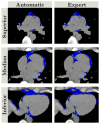Deep Learning for Quantification of Epicardial and Thoracic Adipose Tissue From Non-Contrast CT
- PMID: 29994362
- PMCID: PMC6076348
- DOI: 10.1109/TMI.2018.2804799
Deep Learning for Quantification of Epicardial and Thoracic Adipose Tissue From Non-Contrast CT
Abstract
Epicardial adipose tissue (EAT) is a visceral fat deposit related to coronary artery disease. Fully automated quantification of EAT volume in clinical routine could be a timesaving and reliable tool for cardiovascular risk assessment. We propose a new fully automated deep learning framework for EAT and thoracic adipose tissue (TAT) quantification from non-contrast coronary artery calcium computed tomography (CT) scans. The first multi-task convolutional neural network (ConvNet) is used to determine heart limits and perform segmentation of heart and adipose tissues. The second ConvNet, combined with a statistical shape model, allows for pericardium detection. EAT and TAT segmentations are then obtained from outputs of both ConvNets. We evaluate the performance of the method on CT data sets from 250 asymptomatic individuals. Strong agreement between automatic and expert manual quantification is obtained for both EAT and TAT with median Dice score coefficients of 0.823 (inter-quartile range (IQR): 0.779-0.860) and 0.905 (IQR: 0.862-0.928), respectively; with excellent correlations of 0.924 and 0.945 for EAT and TAT volumes. Computations are performed in <6 s on a standard personal computer for one CT scan. Therefore, the proposed method represents a tool for rapid fully automated quantification of adipose tissue and may improve cardiovascular risk stratification in patients referred for routine CT calcium scans.
Figures












References
-
- Mahabadi AA, Massaro JM, Rosito GA, Levy D, Murabito JM, Wolf PA, O’Donnell CJ, Fox CS, Hoffmann U. Association of pericardial fat, intrathoracic fat, and visceral abdominal fat with cardiovascular disease burden: the Framingham Heart Study. European Heart Journal. 2009;30(7):850–856. - PMC - PubMed
-
- Mahabadi AA, Reinsch N, Lehmann N, Altenbernd J, Kalsch H, Seibel RM, Erbel R, Mohlenkamp S. Association of pericoronary fat volume with atherosclerotic plaque burden in the underlying coronary artery: a segment analysis, (in eng) Atherosclerosis. 2010 Jul;211(1):195–9. - PubMed
-
- Mazurek T, Zhang L, Zalewski A, Mannion JD, Diehl JT, Arafat H, Sarov-Blat L, O’Brien S, Keiper EA, Johnson AG, et al. Human Epicardial Adipose Tissue Is a Source of Inflammatory Mediators. Circulation. 2003;108:2460–2466. - PubMed
-
- Shimabukuro M, Hirata Y, Tabata M, Dagvasumberel M, Sato H, Kurobe H, Fukuda D, Soeki T, Kitagawa T, Takanashi S, et al. Epicardial adipose tissue volume and adipocytokine imbalance are strongly linked to human coronary atherosclerosis, (in eng) Arterioscler Thromb Vasc Biol. 2013 May;33(5):1077–84. - PubMed
Publication types
MeSH terms
Grants and funding
LinkOut - more resources
Full Text Sources
Other Literature Sources
Medical

